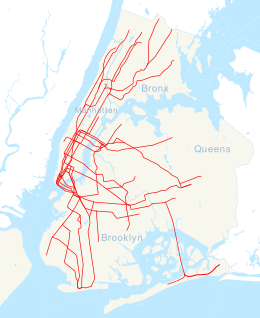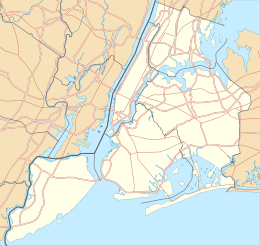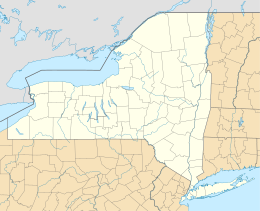railroad.wikisort.org - Station
The 103rd Street–Corona Plaza station is a local station on the IRT Flushing Line of the New York City Subway, located at the intersection of 103rd Street and Roosevelt Avenue.[4] It is served by the 7 train at all times.[5]
103 Street–Corona Plaza | ||||||||||||||||||||||||||||||||||||||||||||||||||||||||||||||||||||
|---|---|---|---|---|---|---|---|---|---|---|---|---|---|---|---|---|---|---|---|---|---|---|---|---|---|---|---|---|---|---|---|---|---|---|---|---|---|---|---|---|---|---|---|---|---|---|---|---|---|---|---|---|---|---|---|---|---|---|---|---|---|---|---|---|---|---|---|---|
 Platform view | ||||||||||||||||||||||||||||||||||||||||||||||||||||||||||||||||||||
| Station statistics | ||||||||||||||||||||||||||||||||||||||||||||||||||||||||||||||||||||
| Address | 103rd Street & Roosevelt Avenue Queens, NY 11368 | |||||||||||||||||||||||||||||||||||||||||||||||||||||||||||||||||||
| Borough | Queens | |||||||||||||||||||||||||||||||||||||||||||||||||||||||||||||||||||
| Locale | Corona | |||||||||||||||||||||||||||||||||||||||||||||||||||||||||||||||||||
| Coordinates | 40°44′59.37″N 73°51′45.84″W | |||||||||||||||||||||||||||||||||||||||||||||||||||||||||||||||||||
| Division | A (IRT)[1] | |||||||||||||||||||||||||||||||||||||||||||||||||||||||||||||||||||
| Line | IRT Flushing Line | |||||||||||||||||||||||||||||||||||||||||||||||||||||||||||||||||||
| Services | 7 | |||||||||||||||||||||||||||||||||||||||||||||||||||||||||||||||||||
| Transit | ||||||||||||||||||||||||||||||||||||||||||||||||||||||||||||||||||||
| Structure | Elevated | |||||||||||||||||||||||||||||||||||||||||||||||||||||||||||||||||||
| Platforms | 2 side platforms | |||||||||||||||||||||||||||||||||||||||||||||||||||||||||||||||||||
| Tracks | 3 | |||||||||||||||||||||||||||||||||||||||||||||||||||||||||||||||||||
| Other information | ||||||||||||||||||||||||||||||||||||||||||||||||||||||||||||||||||||
| Opened | April 21, 1917 | |||||||||||||||||||||||||||||||||||||||||||||||||||||||||||||||||||
| Opposite- direction transfer | Yes | |||||||||||||||||||||||||||||||||||||||||||||||||||||||||||||||||||
| Former/other names | Alburtis Avenue[2] 104th Street | |||||||||||||||||||||||||||||||||||||||||||||||||||||||||||||||||||
| Traffic | ||||||||||||||||||||||||||||||||||||||||||||||||||||||||||||||||||||
| 2019 | 6,399,657[3] | |||||||||||||||||||||||||||||||||||||||||||||||||||||||||||||||||||
| Rank | 64 out of 424[3] | |||||||||||||||||||||||||||||||||||||||||||||||||||||||||||||||||||
| ||||||||||||||||||||||||||||||||||||||||||||||||||||||||||||||||||||
| ||||||||||||||||||||||||||||||||||||||||||||||||||||||||||||||||||||
| ||||||||||||||||||||||||||||||||||||||||||||||||||||||||||||||||||||
| ||||||||||||||||||||||||||||||||||||||||||||||||||||||||||||||||||||
| ||||||||||||||||||||||||||||||||||||||||||||||||||||||||||||||||||||
History
This station opened on April 21, 1917, as Alburtis Avenue, as the easternmost station of an extension of the Flushing line past Queensboro Plaza.[2] It was later renamed 104th Street, giving the possibility of a sealed exit at the north end, before taking its current name of 103rd Street–Corona Plaza. This station still contains signs showing Alburtis Avenue, but which now have been covered up. This station was the eastern terminal for the joint BMT and IRT services on the line until the extension to 111th Street opened on October 13, 1925.[2][6][7][8]
The city government took over the IRT's operations on June 12, 1940.[9][10] The IRT routes were given numbered designations in 1948 with the introduction of "R-type" rolling stock, which contained rollsigns with numbered designations for each service.[11] The route from Times Square to Flushing became known as the 7.[12] On October 17, 1949, the joint BMT/IRT operation of the Flushing Line ended, and the line became the responsibility of the IRT.[13] After the end of BMT/IRT dual service, the New York City Board of Transportation announced that the Flushing Line platforms would be lengthened to 11 IRT car lengths; the platforms were only able to fit nine 51-foot-long IRT cars beforehand.[14][15] The platforms at the station were extended in 1955–1956 to accommodate 11-car trains.[16] However, nine-car trains continued to run on the 7 route until 1962, when they were extended to ten cars.[17] With the opening of the 1964 New York World's Fair, trains were lengthened to eleven cars.[18][19]
As part of the 2015–2019 Capital Program, the MTA would renovate the 52nd, 61st, 69th, 82nd, 103rd and 111th Streets stations, a project that has been delayed for several years but is slated to begin in mid-2020. Conditions at these stations were among the worst of all stations in the subway system.[20]
Station layout
| P Platform level | ||
| Side platform | ||
| Southbound local | ← | |
| Peak-direction express | ← | |
| Northbound local | | |
| Side platform | ||
| M | Mezzanine | Fare control, station agent, MetroCard machines |
| G | Street level | Entrances/exits |

This elevated station has three tracks and two side platforms.[21] The center track is used by the rush hour peak direction <7> express service.[5] Both platforms have beige windscreens and brown canopies supported by green frames and support columns in the center and green waist-high steel fences at both ends. The station names are in the standard black plates with white lettering, though some lampposts at both ends have their original white signs in black lettering.[8][22]
Exits
This station's only entrance/exit is an elevated station house beneath the tracks. A pair of staircases from either side of Roosevelt Avenue between 103rd and 104th Streets go up to the station house, where there is a token booth in the center and a turnstile bank on either side.[23] Both turnstile banks lead to a wooden waiting area/crossunder and have a single staircase going up to either platform.[7][8]
References
- "Glossary". Second Avenue Subway Supplemental Draft Environmental Impact Statement (SDEIS) (PDF). Vol. 1. Metropolitan Transportation Authority. March 4, 2003. pp. 1–2. Archived from the original (PDF) on February 26, 2021. Retrieved January 1, 2021.
- "New Rapid Transit Commission Preparing Plans for Extension of Corona Line to Flushing; Board of Estimate Has Authorized Extension of Line From Corona to New Storage Yards Near Flushing River--Queensboro Subway to Have Connection With Proposed Eighth Avenue Line Near Times Square" (PDF). The New York Times. June 12, 1921. Archived (PDF) from the original on May 18, 2022. Retrieved September 18, 2015.
- "Facts and Figures: Annual Subway Ridership 2014–2019". Metropolitan Transportation Authority. 2020. Retrieved May 26, 2020.
- "MTA Neighborhood Maps: Corona" (PDF). Metropolitan Transportation Authority. 2015. Archived (PDF) from the original on May 5, 2017. Retrieved September 20, 2015.
- "7 Subway Timetable, Effective September 13, 2020". Metropolitan Transportation Authority. Retrieved December 9, 2020.
- "First Trains to be Run on Flushing Tube Line Oct. 13: Shuttle Operation Ordered to 111th Street Station on New Extension". Newspapers.com. Brooklyn Daily Eagle. October 5, 1925. p. 8. Archived from the original on October 26, 2016. Retrieved September 20, 2015.
- "www.nycsubway.org: IRT Flushing Line". www.nycsubway.org. Archived from the original on March 2, 2016. Retrieved February 18, 2016.
- "7 Train". Station Reporter. August 11, 2014. Archived from the original on August 11, 2014. Retrieved February 18, 2016.
- "City Transit Unity Is Now a Reality; Title to I.R.T. Lines Passes to Municipality, Ending 19-Year Campaign". The New York Times. June 13, 1940. ISSN 0362-4331. Archived from the original on January 7, 2022. Retrieved May 14, 2022.
- "Transit Unification Completed As City Takes Over I. R. T. Lines: Systems Come Under Single Control After Efforts Begun in 1921; Mayor Is Jubilant at City Hall Ceremony Recalling 1904 Celebration". New York Herald Tribune. June 13, 1940. p. 25. ProQuest 1248134780.
- Brown, Nicole (May 17, 2019). "How did the MTA subway lines get their letter or number? NYCurious". amNewYork. Archived from the original on March 2, 2021. Retrieved January 27, 2021.
- Friedlander, Alex; Lonto, Arthur; Raudenbush, Henry (April 1960). "A Summary of Services on the IRT Division, NYCTA" (PDF). New York Division Bulletin. Electric Railroaders' Association. 3 (1): 2–3. Archived (PDF) from the original on September 14, 2020. Retrieved January 27, 2021.
- "Direct Subway Runs To Flushing, Astoria" (PDF). The New York Times. October 15, 1949. ISSN 0362-4331. Retrieved October 7, 2017.
- Bennett, Charles G. (November 20, 1949). "Transit Platforms On Lines In Queens To Be Lengthened; $3,850,000 Program Outlined for Next Year to Care for Borough's Rapid Growth New Links Are To Be Built 400 More Buses to Roll Also — Bulk of Work to Be on Corona-Flushing Route Transit Program In Queens Outlined". The New York Times. ISSN 0362-4331. Retrieved April 29, 2018.
- "37 Platforms On Subways To Be Lengthened: All Stations of B. M. T. and I.R.T.in Queens Included in $5,000,000 Program". New York Herald Tribune. November 20, 1949. p. 32. ISSN 1941-0646. ProQuest 1325174459.
- Minutes and Proceedings of the New York City Transit Authority. New York City Transit Authority. 1955. Archived from the original on September 13, 2020. Retrieved August 31, 2016.
- "R17s to the Flushing Line". New York Division Bulletin. Electric Railroaders' Association. 5 (6): M-8. December 1962 – via Issu.
- "TA to Show Fair Train". Long Island Star – Journal. August 31, 1963. Retrieved August 30, 2016 – via Fulton History.
- "A First-class Rapid Ride". Railway Age. Vol. 156, no. 21. June 1, 1964. p. 22. ProQuest 895766286.
- "MTA To Overhaul Six Stations on the 7 Line, Currently in Design Phase". Sunnyside Post. November 19, 2019. Archived from the original on August 19, 2020. Retrieved April 29, 2020.
- Dougherty, Peter (2006) [2002]. Tracks of the New York City Subway 2006 (3rd ed.). Dougherty. OCLC 49777633 – via Google Books.
- Cox, Jeremiah. "103 Street-Corona Plaza (7) - The SubwayNut". www.subwaynut.com. Archived from the original on June 15, 2017. Retrieved February 18, 2016.
- "MTA Neighborhood Maps: Corona" (PDF). Metropolitan Transportation Authority. 2015. Archived (PDF) from the original on May 5, 2017. Retrieved September 20, 2015.
External links
- nycsubway.org – IRT Flushing Line: 103rd Street–Corona Plaza
- The Subway Nut — 103rd Street–Corona Plaza Pictures Archived June 15, 2017, at the Wayback Machine
- 103rd Street entrance from Google Maps Street View
- Platforms from Google Maps Street View
На других языках
- [en] 103rd Street–Corona Plaza station
[ru] 103-я улица — Корона-Плаза (линия Флашинг, Ай-ар-ти)
«103-я улица — Корона-Плаза» (англ. 103rd Street–Corona Plaza) — станция Нью-Йоркского метрополитена, расположенная на линии Флашинг, Ай-ар-ти. Станция находится в районе Корона, Куинс, на пересечении 103-й улицы и Рузвельт-авеню. На станции останавливается маршрут 7 (круглосуточно). Станцию проходит без остановки маршрут <7> (в часы пик в пиковом направлении).Другой контент может иметь иную лицензию. Перед использованием материалов сайта WikiSort.org внимательно изучите правила лицензирования конкретных элементов наполнения сайта.
WikiSort.org - проект по пересортировке и дополнению контента Википедии



